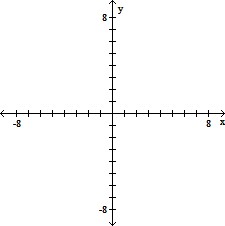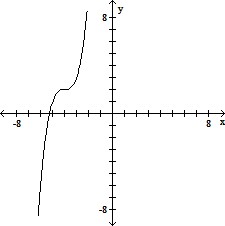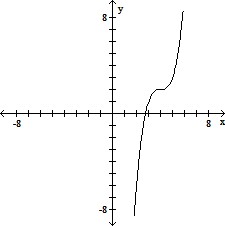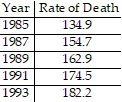Use Gaussian elimination to find the complete solution to the system of equations, or state that none exists.4x - y + 3z=12x + 4y + 6z=-325x + 3y + 9z=20
A. ?
B. {(2, -7, -1)}
C. {(-8, -7, 9)}
D. {(8, -7, -2)}
Answer: A
You might also like to view...
Use a graphing calculator to find the graph of the equation.y = (x - 4)3 + 2
A. 
B. 
C. 
D. 
Perform the indicated operations. Express the answer as a single polynomial in standard form.(5y + 11)(8y2 - 2y - 10)
A. 40y3 + 78y2 - 72y - 110 B. 40y3 + 98y2 + 72y + 110 C. 128y2 - 32y - 160 D. 40y3 - 10y2 - 50y + 11
The diameter of an electric cable is normally distributed, with a mean of 0.9 inch and a standard deviation of 0.02 inch. What is the probability that the diameter will exceed 0.91 inch?
Standard Normal Distribution; z-scores z 0.00 0.01 0.02 0.03 0.04 0.05 0.06 0.07 0.08 0.090.0 0.0000 0.0040 0.0080 0.0120 0.0160 0.0199 0.0239 0.0279 0.0319 0.03590.1 0.0398 0.0438 0.0478 0.0517 0.0557 0.0596 0.0636 0.0675 0.0714 0.07530.2 0.0793 0.0832 0.0871 0.0910 0.0948 0.0987 0.1026 0.1064 0.1103 0.11410.3 0.1179 0.1217 0.1255 0.1293 0.1331 0.1368 0.1406 0.1443 0.1480 0.15170.4 0.1554 0.1591 0.1628 0.1664 0.1700 0.1736 0.1772 0.1808 0.1844 0.18790.5 0.1915 0.1950 0.1985 0.2019 0.2054 0.2088 0.2123 0.2157 0.2190 0.22240.6 0.2257 0.2291 0.2324 0.2357 0.2389 0.2422 0.2454 0.2486 0.2517 0.25490.7 0.2580 0.2611 0.2642 0.2673 0.2704 0.2734 0.2764 0.2794 0.2823 0.28520.8 0.2881 0.2910 0.2939 0.2967 0.2995 0.3023 0.3051 0.3078 0.3106 0.31330.9 0.3159 0.3186 0.3212 0.3238 0.3264 0.3289 0.3315 0.3340 0.3365 0.33891.0 0.3413 0.3438 0.3461 0.3485 0.3508 0.3531 0.3554 0.3577 0.3599 0.36211.1 0.3643 0.3665 0.3686 0.3708 0.3729 0.3749 0.3770 0.3790 0.3810 0.38301.2 0.3849 0.3869 0.3888 0.3907 0.3925 0.3944 0.3962 0.3980 0.3997 0.40151.3 0.4032 0.4049 0.4066 0.4082 0.4099 0.4115 0.4131 0.4147 0.4162 0.41771.4 0.4192 0.4207 0.4222 0.4236 0.4251 0.4265 0.4279 0.4292 0.4306 0.43191.5 0.4332 0.4345 0.4357 0.4370 0.4382 0.4394 0.4406 0.4418 0.4429 0.44411.6 0.4452 0.4463 0.4474 0.4484 0.4495 0.4505 0.4515 0.4525 0.4535 0.45451.7 0.4554 0.4564 0.4573 0.4582 0.4591 0.4599 0.4608 0.4616 0.4625 0.46331.8 0.4641 0.4649 0.4656 0.4664 0.4671 0.4678 0.4686 0.4692 0.4699 0.47061.9 0.4713 0.4719 0.4726 0.4732 0.4738 0.4744 0.4750 0.4756 0.4761 0.47672.0 0.4772 0.4778 0.4783 0.4788 0.4793 0.4798 0.4803 0.4808 0.4812 0.48173.0 0.4987 0.4987 0.4987 0.4988 0.4988 0.4989 0.4989 0.4989 0.4990 0.4990? A. 0.1915 B. 0.2785 C. 0.6170 D. 0.3185 E. 0.3085
Solve the problem.The rates of death (in number of deaths per 100,000 population) for 20-24 year olds in the United States between 1985-1993 are given below. (Source: NCHS Data Warehouse)  A logarithmic equation that models this data is y = 57.76 + 48.56 ln x where x represents the number of years since 1980 and y represents the rate of death in that year. Use this equation to predict the year in which the rate of death for 20-24 year olds first exceeds 200.
A logarithmic equation that models this data is y = 57.76 + 48.56 ln x where x represents the number of years since 1980 and y represents the rate of death in that year. Use this equation to predict the year in which the rate of death for 20-24 year olds first exceeds 200.
Fill in the blank(s) with the appropriate word(s).